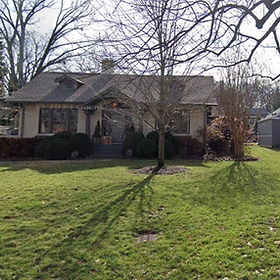
Historic Preservation Overlays
A Layered Approach to Preserving City Character

About Historic Overlays
The Preservation Society of Nashville values historic overlays. We believe an increased focus on strengthening and adding to the city’s overlays could help save our valuable historic resources.
A historic overlay is a zoning tool used to protect the architectural and historical character of Nashville's neighborhoods by managing growth and change through public design reviews. It is "layered" on top of the base or land-use zoning of an area and does not impact the use of properties. Historic overlays are locally designated and administered by the Metropolitan Historic Zoning Commission (MHZC), ensuring that changes to properties align with the neighborhood's historical significance.
Changes for locally designated properties are guided by the ordinance and design guidelines. The guidelines are based on national standards and customized for specific neighborhoods. They provide direction for project applicants and ensure that all applicants are treated fairly.
Most notably, in the City of Nashville, a historic preservation zoning overlay is the only tool to prevent demolition.
Main Types of Historic Overlays
In Nashville, there are currently six (6) types of historic overlays, but three (3) types are used most frequently. All historic overlay types and the designation process can be found in the Metro Historic Zoning Handbook.





.png)
Current Neighborhood & District Overlays
The historic overlay process is administered and managed by the Metro Historic Zoning Commission. Below is a snapshot of the program. For more information and to apply for an overlay, please visit their website.
The Lockeland Springs-East End Neighborhood Conservation overlay preserves one of Nashville’s most intact early 20th-century streetcar suburbs, blending Queen Anne, Craftsman, and Classical Revival architecture. Like other conservation overlays, it regulates exterior changes—new construction, demolitions, and major additions—while exempting minor alterations like siding or fence replacements.
NEIGHBORHOOD
Districts 2, 5, 6, 7
Est. 1989

The Blakemore Urban Design Overlay (UDO) preserves the early 20th-century character of this distinctive Wedgewood Avenue corridor. Established in 1989 as part of a Planned Unit Development (PUD), this overlay regulates building placement, scale, and architectural features to maintain compatibility with the area’s Tudor Revival, Craftsman, and Colonial Revival-style structures.
NEIGHBORHOOD
Districts 17, 18, 19, 23
The Richland-West End Neighborhood Conservation Overlay protects the early 20th-century character of one of Nashville’s most intact historic suburbs. It focuses on regulating visible exterior changes—new construction, additions, demolitions, and relocations—while allowing sensitive updates. Unlike stricter historic overlays, it does not review exterior alterations like siding or fence replacements.
NEIGHBORHOOD
District 24
The Edgefield Historic District Overlay protects Nashville’s first National Register-listed residential district (1977), preserving its 19th-century origins as an elite suburb and early 20th-century transformation into a vibrant streetcar neighborhood. This overlay regulates all exterior changes—including new construction, demolitions, and architectural details—with stricter oversight than conservation overlays.
HISTORIC DISTRICT
Districts 6, 7, 17, 19

How to Apply
for an Overlay
Applying for a neighborhood overlay in Nashville involves a collaborative process between residents, local leaders, and city officials. This guide outlines the steps necessary to initiate and navigate the overlay application process, ensuring that your neighborhood's unique character is preserved while accommodating thoughtful growth and development.

Overlay Videos and more...
PSN Videos
PSN Videos


PSN Preservation-in-Motion Series | Episode 1: Understanding Nashville's Historic Overlays

Historic Preservation Overlay 101

































